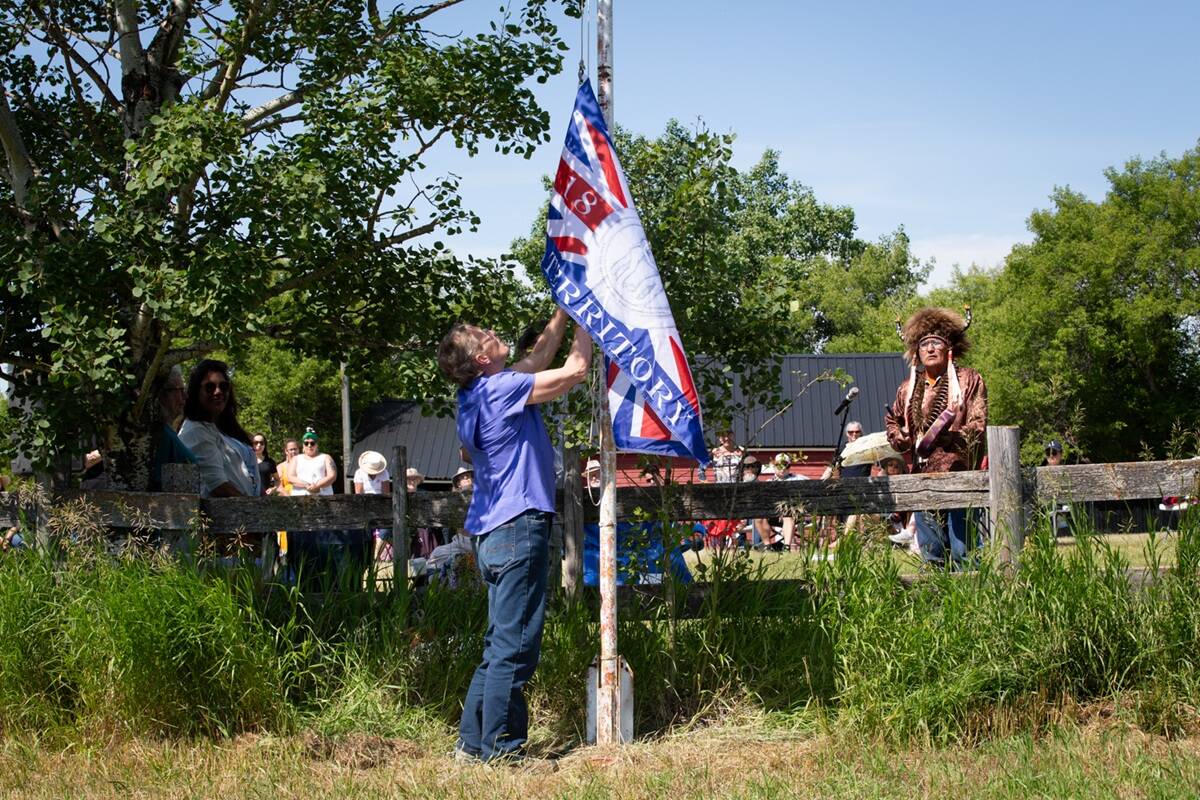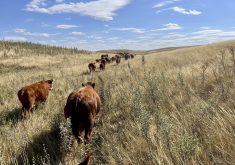Most agree that growing up on a farm or ranch contributes to a wonderful childhood. The practical life lessons that children gain from being raised around livestock can provide a sense of responsibility, respect for risk, a solid work ethic, and an appreciation for where food comes from and the circle of life.
However, the logistics of raising kids while running a cattle business can be daunting.
“As a business owner, a farmer, there is no mat leave,” says Amy Hill, a mixed farmer located in Cooks Brook, N.S. Hill, who is the primary day-to-day operator on her first-generation farm, has tried various child care solutions for her kids who are now nine and almost five years old.
Read Also

Treaty Land Sharing Network expands reach in Saskatchewan and Alberta
The Treaty Land Sharing Network, which connects land holders with First Nations and Metis people, has expanded since it began in 2018
Hill says in her experience there is a fine balance between the cost of child care and running a productive and profitable business. “When (our kids) were under five, I had to be less productive or spend money which meant the farm took in less.”
Farm and ranch child care can be complicated. There are busy seasons when parents need to be out at odd hours, ranches are often in remote or rural locations, and there are fewer daycare spaces or daycare providers to draw from. Many beef producers also have off-farm jobs that can further strain child care needs.
What works for one family and situation will not necessarily work for another. What works for a family for a few months, may not work forever. However, cattle producers are resilient and many have found unique solutions to a universal problem.

When daycare is a chore
Concerning regulated daycare facilities, many producers experience a lack of availability. Or, strict operating hours or locations may not suit their particular situation.
Jacquelyn Wolf, an Alberta rancher and nurse, says a subsidized child care facility can be tough to get into, especially if you have multiple kids. “Our options were for me to take kids to town with me 40 minutes away or go private and only travel 15 minutes.”
They opted to put their two young kids into a nearby private day home. While this option is more expensive, the benefits outweigh the costs.
“There are fewer kids, (our provider) feeds them lunch and she is super flexible for us,” Wolf says.
“If we had gone with the town option, we most likely wouldn’t send kids on the days that I don’t work, which would limit me from participating in farming activities.”
Because Wolf and her husband, Garrett, are the sole operators on their farm, the operation relies on her active involvement and the day home facilitates her ranch work. “If Garrett is working off the farm, I’m the one who does chores which are possible with both kids but definitely a lot harder.”
Hill’s peak busy seasons on her Maritime farm are spring and summer. For her, full-time daycare was not feasible. During COVID, she hired a student through a government summer student program to provide in-home child care. She emphasizes that it was a one-time special circumstance, and it took a lot of advocating on her part to justify her need.
“The best thing is for farmers to be able to do the work in the safest way possible and most productive way possible,” Hill says. With COVID restrictions, that year she estimates it would have taken two or three student employees to cover her farm responsibilities whereas she was able to hire one student to watch her kids so she could get out and do the work.
Along for the ride
Ricky Seelhof ranches with her husband, Chad, and their three teenage children in the interior of British Columbia. Now that her kids are older, Seelhof looks back at her years of raising their babies and raising cattle with fondness.
“We didn’t really do anything innovative,” she says, but adds they were keen to incorporate their kids in daily ranch work. “You kind of have to figure it out.
“We always had a Ranger so they’d be in their car seats with us,” Seelhof recalls. On days when it wasn’t feasible to juggle parenting with working outside, especially in extreme cold, they switched gears and Chad did the work solo.
She says there were moments while parenting young kids that made her question some of their choices but ultimately, she feels her children benefited from their ranch upbringing.
“When you’re a little more remote and isolated in a sense, there are days you do feel like it can be a lonely life. You think, ‘Are we doing the right thing?’
“In the long run, they are so mature because of it.” Seelhof adds ranch kids gain a lot of real-life experiences and develop valuable problem-solving skills. “Life isn’t easy or handed to you. You kind of have to deal with stuff,” she says, of her kids’ ability to persevere.
“As ranch kids, they hear it all. They are there day-to-day, whereas parents who go work at their job, they leave their job at work and come home,” she says. On a ranch, this is both their work and their life, she adds.
Now that their family is growing up and their oldest has graduated and moved away, Seelhof has new considerations for integrating their children on the ranch. “When my kids were little, I didn’t think about what would happen as they got older,” she says. “Now that they are older, what is your next step, and how does that look business-wise?”
Another pair of hands
Alberta rancher Justin Hozack says his family has had a child care provider come into their home five days a week. “It has been a game changer,” says Hozack, who appreciates being able to bring his young kids along for ranch work but has the option to drop them off if it’s too long of a day or they otherwise need a break.
Aimée Ferré Stang and her husband, Sheldon, tried many child care options on their west central Saskatchewan farm before sourcing seasonal au pairs from France to look after their young sons.
“Overall, it was a good experience,” says Ferré Stang, who hired two different employees over two different summers.
Ferré Stang, who is bilingual, found an added benefit of providing her kids with more exposure to the French language.
Hill also hired an au pair for two years on her Nova Scotia farm. “It’s a beautiful thing if you can get someone in,” Hill says. However, she admits it is expensive.
“We found it necessary and worth it for us,” says Hill, but adds that when your profit margin is small, it may not be feasible to spend that much on child care. Ferré Stang agrees many people don’t consider au pairs because there are cheaper daycare options.
Ferré Stang cautions that it takes time and effort to find the right person but their family had good experiences both times. She followed a co-worker’s recommendation to find a match through aupairworld.com and also used a government program called International Experience Canada for placement. Both required paperwork and fees.
“It took about six months to get them here,” Ferré Stang says.
It’s important to clearly outline expectations and foster a connection, says Ferré Stang. “They need to understand that this is a commitment. It’s not going to be totally easy.”
Once she hired her placements, Ferré Stang built a connection and conveyed enthusiasm before they arrived. “I would message pictures of scenery from around here, build a bridge. That was important.”
She adds that you may need to provide support or mentorship to deal with challenges such as homesickness. “If they are having a hard day, they need someone to lean on.”
Ferré Stang conducted a few video interviews including calls to meet the kids. “Make sure that you have someone you have a good feeling about too. Instincts have a lot to do with it,” she says. “Both girls met the kids (through video calls) and I gauged their reactions.”
Ferré Stang has a finished basement with privacy for the au pair’s accommodations. It did take a bit of getting used to having someone else living in their home, she says, but it was also nice to have another adult around.
Regardless of the farm and family situation, raising kids and finding child care solutions in a rural setting requires patience, persistence and money. There are some compromises, but when a solution comes together, the payoff for most families is well worth it.
“When you’re in the thick of it, it’s difficult,” says Hill. “When I look back and see, I’m so glad my kids grew up this way.”
Other childcare ideas from farm and ranch families
Accessing daycare can be a challenge but some communities address the need head-on. Janine Paly, an Alberta farmer and agrologist in the County of Thorhild, explained how her community rallied to develop a new daycare within their school.
“The local municipal government provided support with a startup loan,” she says. The Co-op store provides a donation that the daycare uses to purchase snacks.
“The daycare is open from 6:30 a.m. to 5:45 p.m.,” Paly says, which helps provide a greater range of dropoff and pickup times.
For families with medically complicated children, this puts additional pressure on rural child care needs, as one ranch parent explained.
“I put blinders on when I paid for the private day home because I needed a little normalcy,” explained one parent. Travelling for quality — but expensive — care was a worthwhile tradeoff that allowed them to do things to support their ranch, gave them time to recharge and also improved their overall well-being.
Ranch or farm ownership can also play a role in whether children are allowed to tag along for ranch-related work or not. For example, one ranch employee says they are sensitive to health and safety implications for their employer if something doesn’t go as planned. “There are different pressures and timelines that don’t make it easy for a two-year-old and six-year-old to tag along.”
Many parents hire neighbouring teenagers for short-term child care during school breaks, weekends, or summer. A bonus is if teens have a driver’s license and a means to get to and from where the kids need care.
While some farmers don’t like the idea of travel time to daycare, one family uses their three-hour total commute time to incorporate homeschool podcasts and special visiting time (when their kids are with them) and other audio resources when they are solo.
If there are willing family members or neighbours nearby, reach out for help. This may be a temporary solution or perhaps fill a gap on occasions when it is too cold or hot for children to be outdoors all day, or when kids may be sick and unable to attend daycare.
















